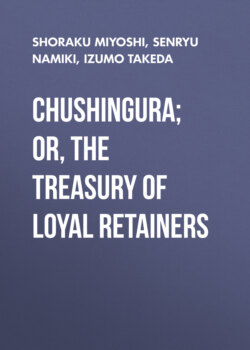Читать книгу Chushingura; Or, The Treasury of Loyal Retainers - Shoraku Miyoshi - Страница 16
На сайте Литреса книга снята с продажи.
THE GENROKU PERIOD
ОглавлениеTable of Contents
Some eighty years after the establishment of the Tokugawa Shogunate began the Genroku period. The Shogun at the time was the fourth of Iyeyasu’s line. No insurrection was feared at home and there was as little danger of the country’s isolation being disturbed by foreign invasion, for no foreigner was allowed to trade in Japan with the exception of the Dutch and Chinese, whose trade was confined to Nagasaki. The country, in short, enjoyed absolute peace and grew in wealth and prosperity. Such was the condition of the land in the Genroku period, which takes its name from the Genroku era (1689–1701) and extended over some fifty years beginning with the Tenna era in 1681 and ending with the Kyoho era in about 1735. It was a period of great importance in the history of Japanese manners, institutions, and literature. The first years of the Tokugawa régime were a period of turbulent militarism and its last years that of indolence and immorality; in the Genroku period, however, the rough militaristic spirit was nearly gone, but the people had not yet fallen into weak and effeminate ways; luxury and extravagance had commenced their sway, but the brave military spirit had not yet vanished. It marked, like the Heian period of the ninth and tenth centuries, the highest stage of Japanese civilisation; and with the dark age of internecine wars intervening between these two periods, it was, indeed, our age of renaissance.
During this period, Bushido, in spite of some evils that attached to it, reached its highest level. This peculiar spirit of Japan had been influenced in the earlier ages by the doctrines of Buddhism; but coming under the influence of Confucianism when the Tokugawa family came into power, it became a cult of complete growth and took its final form early under the Tokugawa rule. But Bushido, like all other institutions, was bound to undergo changes as time went on. Under Shogun Iyetsuna (1650–1680), the fourth of the Tokugawa line, the old sturdy military spirit began to decline in Yedo; and under his successor Tsunayoshi (1680–1709), the Genroku period came in with its love for luxurious living, display, and immorality, with the result that Bushido which had been developed to the highest degree among the warriors of the Eastern Provinces left Yedo, the centre of those provinces, and sought refuge in the country, where it remained unimpaired among the simple samurai of the daimiates. The Ako vendetta was a striking instance of its hold upon the country samurai.
The changes of manners under the Tokugawa Shogunate spread as a rule from Yedo to the provinces. But in the early years of that Shogunate Yedo was not yet the centre of Japanese civilisation; for though it held the foremost position in military arts, it was in literature, art, and other things inferior to Kyoto and Osaka which were as cities far older. The Eastern Provinces changed their manners by imitating those of these two western cities. But the manners and customs of the latter cities were at the time almost directly opposite to those of Yedo. They were soft, frivolous, and elegant to effeminacy; Kyoto had, since it became the capital of the country in 794, been the centre of Japanese civilisation, while Osaka which had been from the oldest times an important port for vessels sailing to and from the western provinces, became especially prosperous from the days of Hideyoshi the Taiko (1536–97); and while they had long lost the simplicity and straightforwardness of more primitive districts, they were less moved by a sense of honour, more impelled by desire for wealth, and became more and more luxurious as they advanced in civilisation, and naturally grew more fond of ostentation.
The characteristics of the Genroku period were then represented by the manners and tastes of Kyoto and Osaka. In that period, though Yedo was firmly established as the political centre of the country, it had to import from Kyoto and Osaka their literature and customs, which were thereupon acclimatised in Yedo. The true Yedo spirit and manners did not come into being until a century later, that is, the beginning of the nineteenth century.
